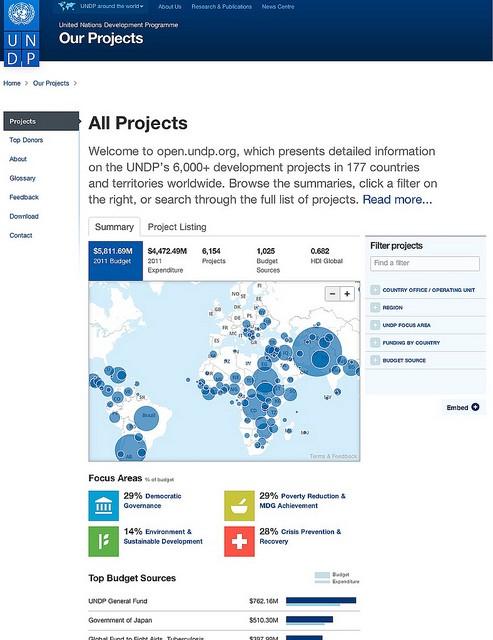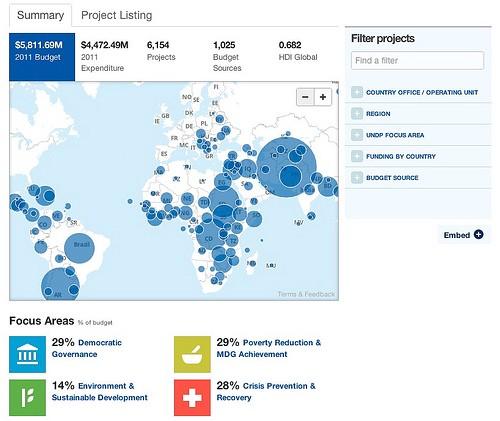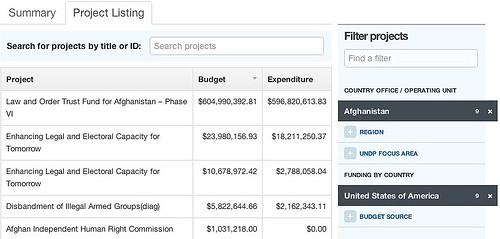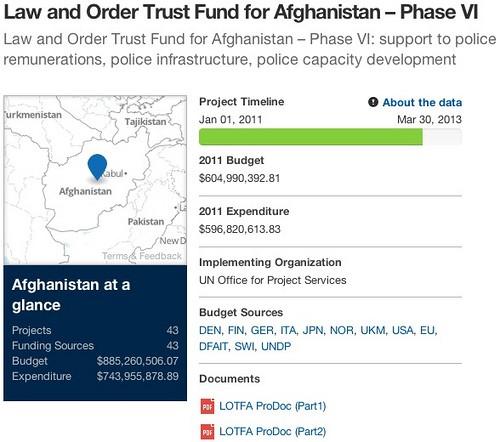The United Nations Development Programme (UNDP) just launched open.undp.org, a project and funding data browser that maps 6,000+ projects in 177 countries and discloses more than $5.8 billion in funding. This is a big step in the open data space. The new site uses state of the art web technology to improve international aid by exposing vital information in a visually compelling fashion and machine readable formats. Open.undp.org is a significant new web property in the United Nations family that shows the growing traction of organizations embracing web technology to further aid transparency and accountability. Its launch comes in the same year as the UNDP’s start to disclose project information under the standards of the International Aid Transparency Initiative (IATI)

Front page of open.undp.org
This is the most powerful and fastest project browser we have ever built, letting users drill into any funding category, any country, and by any donor or recipient, all the way down to an individual project’s finances and the outcomes that it is producing. And most importantly, every view, facet, and project is linkable via a sensible URL that appears in the browser’s address bar. This URL can be easily shared using any means of electronic communications. While not rocket science, this is key for making open.undp.org a solid reference resource in a world where almost all communication is on the web.
Flat and fast
The site is designed to be more like an app — light and fast — letting users quickly filter across everything. With open.undp.org we further pursue our philosophy of CMS free websites. The site is all built in HTML, JavaScript, and JSON-formatted data, hosted on GitHub pages and compiled by Jekyll. This approach allows for an incredibly robust and fast architecture. There is no database behind the site. There is no dynamic page generation server-side — it’s all static. Backbone.js is used to manage the data and the many ways it is displayed and updated. The updating workflow is simple — the UN exports their data from their existing Oracle-based data warehouse, runs a simple script that generates the JSON files that power open.undp.org, and uploads them to the site. We will follow up with more technical details in a future post.
Access to raw data, openly licensed
All information on open.undp.org can be downloaded or accessed via a RESTful API in CSV or JSON formats for quick reuse in Spreadsheet programs like Excel or custom applications. The data is openly licensed, merely requiring attribution to use in any commercial or non-commercial scenario.

Download dialog on open.undp.org
2013 Goals
Starting in early 2013, the site will be updated quarterly and all 2012 data will be added (currently only 2011 data in included). Previously UNDP published a data set for 2009–2010 annually, as a spreadsheet. UNDP Administrator Helen Clark noted:
“We are committed to working in the open, and we will continue improving the quality, quantity, and timeliness of our reporting so that our partners can monitor their investments in fighting poverty, supporting human development, and securing a sustainable future for all.”
Working with the UNDP open data and communication team over the past three months has been incredible. They embraced a highly minimalist app design and UI and were able to run incredibly fast in opening up their data. We are excited to see where they take this site in the future.
Site highlights
Front page
The homepage shows a map of projects around the world, indicating where the most money is being spent.

###Filtering
Projects can be filtered by selecting an item in one or more categories. In this example we seleced the Afghanistan country office plus funding sources from the United States.

###Every Project
Also available is a searchable and sortable list of each individual project included in the current filter. Here we see projects in Afghanistan that are being contributed to by U.S. sources, sorted by total budget.

###Project Pages
Clicking on a project title will load that project’s specific details. These pages include the project’s timeline, financial data, related documents, relative tweets and photos, and each individual output.

Check out open.undp.org to explore the data and visualizations.
What we're doing.
Latest